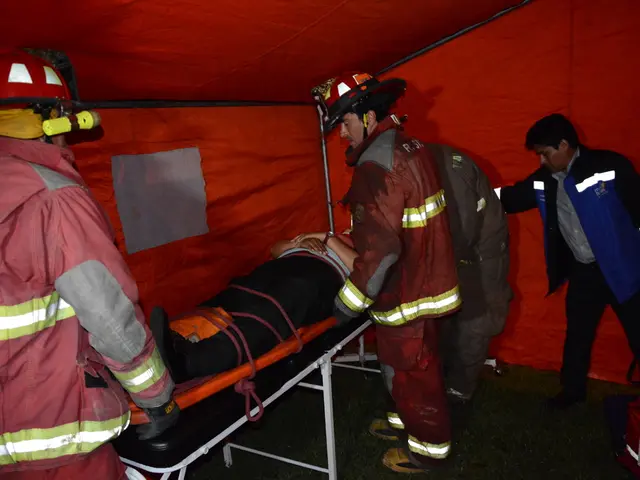Distinguishing between Age Spots and Skin Cancer: Recognizing the Key Differences
Harmless Age Spots vs. Skin Cancer: A Comprehensive Guide
As people age, skin changes inevitably occur, with harmless age spots being one of the common alterations. However, these spots may resemble certain types of skin cancer or precancerous growths, leading to confusion among individuals. Recognizing the differences between age spots and skin cancer can help distinguish when medical advice is necessary.
Both age spots and skin cancer are prevalent on areas of the skin exposed to the sun, such as the hands, face, and shoulders. Examining crucial discrepancies in texture, color, and placement can aid in diagnosing these conditions more accurately.
Age Spots: Distinguishing Features
Age spots, also known as solar lentigines or liver spots, are small, darker patches that develop on the skin as a result of the body producing excess melanin to protect from the sun's UV radiation. These spots are generally flat, smooth, and do not itch or feel crusty. Age spots typically appear on those with lighter skin, although they can develop on any skin tone. They usually appear from middle age onward.
Skin Cancer: Identifying the Threat
Unlike age spots, skin cancer poses a genuine risk. It is a type of cancer that develops due to damage from UV radiation or other environmental or genetic factors. Skin cancer cells mutate, grow, and spread rapidly. Skin cancer is more likely to form on areas frequently exposed to sunlight.
The three most common types of skin cancer are:
- Basal cell carcinoma
- Squamous cell carcinoma
- Melanoma
Another condition that may be mistaken for an age spot is actinic keratosis, a precancerous growth caused by UV radiation damage.
Can Age Spots Turn into Cancer?
Age spots, by definition, are harmless and do not transform into cancer. However, actinic keratosis, which may appear similar to age spots, is a precancerous growth that, left untreated, may develop into skin cancer.
Symptom Comparison
Differentiating symptoms can help a person understand which condition is occurring.
Age Spot Symptoms:
- Flat and smooth
- Yellow, brown, or gray
- Defined with clear borders
- Between a few millimeters to several centimeters in size
- On sun-exposed areas, such as the face, hands, shoulders, and other vulnerable areas
Skin Cancer Symptoms:
- May have an asymmetrical shape
- Irregular, blurred, or ragged edges
- Changing size, color, or shape
- Multiple colors on the same spot
- Pink, blue, purple, black, or brown discoloration
- Raised, red patches
- Pale or yellow firm patches, resembling scars
- Pain, itching, oozing, or bleeding
- Crusty or scaly patches
- Raised edges that lower in the center
When to Contact a Doctor
General advice is to speak with a healthcare professional if any unusual changes occur on the skin. Early detection of skin cancer can simplify the treatment process and improve health outcomes. Consider seeking medical advice if a mark on the skin:
- Changes in color, shape, size, or location
- Looks different from other marks on the skin
- Itches, crusts over, or bleeds without healing within four weeks
Diagnosis
A doctor or dermatologist will perform a physical examination of age spots to determine if they are something other than an age spot. They will assess appearance, texture, and placement. If unsure, they may perform a skin biopsy to test for other conditions, such as skin cancer or actinic keratosis.
Treatment
Treatment for age spots is not always necessary since they do not pose a threat. People may choose specific treatments to reduce their appearance. Possible treatments include creams and lotions, as well as laser treatments, cryosurgery, microdermabrasion, and chemical peels.
Skin Cancer Treatment
Skin cancer treatment varies depending on the type and stage of cancer and an individual's specific circumstances. If possible, a doctor may surgically remove basal cell and squamous cell cancers. In some cases, the cancer's position may prevent surgical treatment. Other treatments may include topical therapies, radiation therapy, chemotherapy, immunotherapy, and systemic medication.
Summary
Age spots, skin cancer, and actinic keratosis can closely resemble one another, but recognizing differences in appearance, symptoms, and treatments is crucial. Actinic keratosis is a precancerous growth that may develop into squamous cell carcinoma if left untreated. A person should consult a doctor about any unusual changes to the skin to ensure early skin cancer detection and optimal health outcomes.
- Despite being harmless, age spots could sometimes resemble precancerous growths, such as actinic keratosis, leading to concerns among seniors.
- In contrast, skin cancer, a medical-condition posing a genuine risk, arises due to UV radiation or other factors and exhibits symptoms like multiple colors, irregular edges, and crusty, scaly patches.
- The science of dermatology classifies skin cancer into three main types: basal cell carcinoma, squamous cell carcinoma, and melanoma, all of which require medical attention.
- Skin-care routines focusing on health-and-wellness and skin-conditions should entail regular checks for any changes in skin textures, discolorations, or growths that might indicate skin cancer or other skin-conditions.
- When determining if an alteration on the skin is a harmless age spot or something more serious like skin cancer or otherskin cancer, seeking professional help from a dermatologist or healthcare provider is always advisable.








